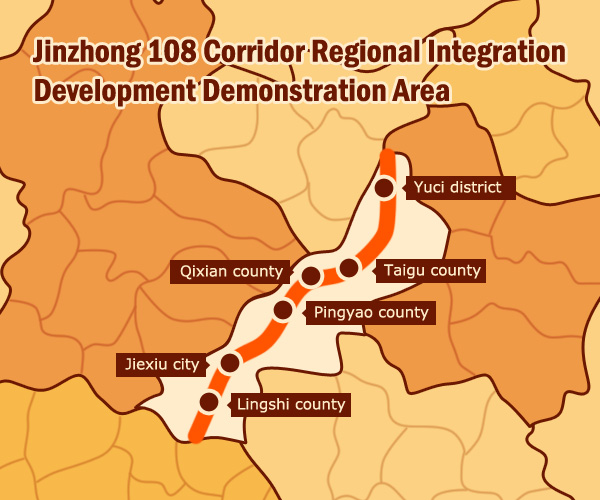The Jinzhong 108 Corridor Regional Integration Development Demonstration Area (hereinafter referred to as the Jinzhong 108 Corridor Area), in Jinzhong city, North China's Shanxi province, refers to the area along National Highway 108, covering Yuci district, Taigu county, Qixian county, Pingyao county, Jiexiu city and lingshi county.
The Jinzhong 108 corridor area has an area of 6,422 square meters, 40 percent of the city. Its population amounts to 2.41 million, 73 percent of the city.
The Jinzhong 108 Corridor Area can be divided into northern, middle, and southern parts with different investment focuses.
The northern part, covering the Jinzhong economic and technological development zone, Yuci industrial park, and the Yuci district, is concentrated on advanced equipment manufacturing and high-tech enterprises, including automobiles, hydraulic machinery, machining, and precision casting.
The middle part including Qixian county, Taigu county, and Pingyao county will build a national tourist destination and a national modern agriculture demonstration area by developing culture, tourism, modern agriculture, glassware, food, and finance.
Jiexiu city and Lingshi county constitute the southern part of the Jinzhong 108 corridor area, and aim to introduce coal chemical facilities, coal gasification, coal electrification, and new materials enterprises to become the province's green energy and new materials base.
The area boasts the following advantages:
Original place of the spirit of Shanxi merchants
Convenient location
Rich tourist resources
Solid industrial foundation
Shanxi's key access to North China, West China and Central China
Supply base of agricultural and sideline products for Taiyuan
The biggest tourist distribution center in Shanxi province
An important component of the Taiyuan city cycle
The area has made achievements in following aspects:
The area's economy accounted for over 70 percent of Jinzhong city regarding major economic indicators during the 12th Five-Year Plan (2011-2015).
Yuci district, Jiexiu city, and Lingshi county rank among top 20 in Shanxi province in terms of economic activity aggregation.
The Jinzhong 108 corridor area has a clear industrial pattern with its southern, middle and northern parts complementing each other.
|
|
|
|
|
|
|
|

The city of Jinzhong, in central Shanxi province, sits next to Taihang Mountains to the east, the Fenhe River to the west, and Taiyuan, the provincial capital, to the north, on a 16,400-square–kilometer space, and has a population of 3 million.
It has a long history and, at the same time, great development potential. It is the home of many famous and talented people and the Shanxi merchants who were famous for their business in the past. From the early 17th century to the mid-19th century, its businessmen opened shops all across the country, and even went as far as Japan, West Asia, Russia, and Mongolia, similar to Anhui province's merchants.
It had China's first bank-style organization, the Rishengchang Piaohao (a firm for exchange and transfer for money), established in 1824, a symbol of its financial importance at the time. It has long been a major grain, vegetable, animal products, and fresh and dry fruit producer, with developed agricultural technology.
It has large multiple reserves, with more than 20 types, including iron, alumina, sulfur, gypsum, clay, and good quality coal and is one of China's 10 coal bases.
It began developing its industries long ago and is a pillar in machinery, coal, metallurgy, and chemicals, with large textile machinery, glassware, and medicine production.
Its scenic spots account for almost a tenth of the province's total, and its old Pingyao city is a world heritage site, along with its Shanxi merchant culture tourist area and it continues to improve its tourism infrastructure to make itself more competitive.